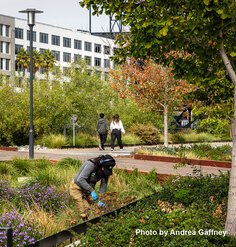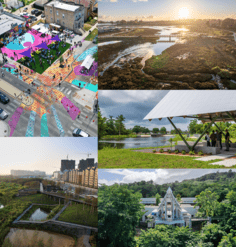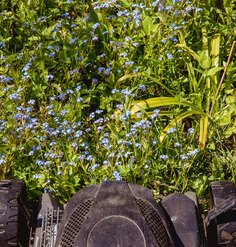From the Field: Teaching Stewardship in Childhood Education
By Mark Storie, BLA, Byoung-Suk Kweon, Ph.D., PLA, and Christopher D. Ellis, Ph.D., PLA, ASLA
Our Case Study Investigation (CSI) research team at the University of Maryland is currently investigating landscape performance benefits of K-12 school environments. One site that we are studying is the Willow School in Gladstone, New Jersey. Teachers at the school actively look for ways to use the landscape in their class for teaching.
School hallways are probably one of the best places to view the evidence of environmental education. During our school visit, we had the opportunity to meet with second grade teacher Peter Parker who gave us a brief tour of his classroom and explained how his class uses the campus landscape and sustainable features in subjects like history, science, and English. Looking at the student work that was featured throughout the classroom and hallway, we could see just how involved his students are in actively studying the landscape.
Every year the second grade science class conducts field observations of the school’s constructed wetland pond. These findings are compiled and displayed in the hallway just outside of the classroom, showing students the increase in numbers and varieties of wetland fauna over the last 9 years which helps to shed light on the health of the wetland ecosystem.
In the English class, Mr. Parker’s students learn the functions of the school’s wastewater system while writing short descriptions of how the system works. Diagrams accompany the written descriptions to help students visualize how the system functions through each step in the process.
In the history class, students uncover the history of the land by excavating 1-foot grids, much as an archaeologist would do when uncovering a historical site. Over the last 9 years, Mr. Parker’s students have compiled an impressive collection of artifacts, some dating back to pre-colonial times. Students are able to view these artifacts and make conclusions about how the land had been used previously. According to Parker, when students gain a historical perspective of the school’s site, they begin to ask deeper questions about how our culture’s relationship with the land has changed over time.
All students at the Willow School have opportunities to engage with the landscape. Each grade level takes part in the school’s community vegetable and fruit gardens which provide the school’s cafeteria with fresh local produce. Recycling programs in the school provide roughly 280 pounds per year of nutrient-rich compost that is incorporated into the community garden.
Evidence of active engagement can also be seen in the hallway. Outside of every classroom, students place their outdoor boots which are often times covered in mud on rainy days. Looking down the hallway at all the boots from the many classrooms, one can see just how many students are actively engaged in the landscape.
Professors Byoung-Suk Kweon and Christopher D. Ellis and student Research Assistant Mark Storie are participating in LAF’s 2012 Case Study Investigation (CSI) program. Their case studies will quantify the benefits that school landscapes have on school children, teachers, staff, their surrounding communities, and the enivornment. Any opinions expressed in this article belong solely to the author. Their inclusion in this article does not reflect endorsement by LAF.











